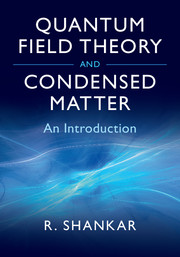Crossref Citations
This Book has been
cited by the following publications. This list is generated based on data provided by Crossref.
Chou, Yang-Zhi
Nandkishore, Rahul M.
and
Radzihovsky, Leo
2018.
Mott glass from localization and confinement.
Physical Review B,
Vol. 97,
Issue. 18,
Chou, Yang-Zhi
Nandkishore, Rahul M.
and
Radzihovsky, Leo
2018.
Gapless insulating edges of dirty interacting topological insulators.
Physical Review B,
Vol. 98,
Issue. 5,
Chou, Yang-Zhi
Nandkishore, Rahul M.
and
Radzihovsky, Leo
2019.
Localized surfaces of three-dimensional topological insulators.
Physical Review B,
Vol. 99,
Issue. 16,
Cipcigan, F. S.
Crain, J.
Sokhan, V. P.
and
Martyna, G. J.
2019.
Electronic coarse graining: Predictive atomistic modeling of condensed matter.
Reviews of Modern Physics,
Vol. 91,
Issue. 2,
Wang, Yan-Qi
and
Moore, Joel E.
2019.
Boundary edge networks induced by bulk topology.
Physical Review B,
Vol. 99,
Issue. 15,
Gralla, Samuel E.
2019.
Bosonization of strong-field pair plasma.
Journal of Cosmology and Astroparticle Physics,
Vol. 2019,
Issue. 05,
p.
002.
Chou, Yang-Zhi
2019.
Localization-driven correlated states of two isolated interacting helical edges.
Physical Review B,
Vol. 99,
Issue. 4,
Reja, Sahinur
Fertig, H. A.
and
Brey, L.
2019.
Spin stiffness and domain walls in Dirac-electron mediated magnets.
Physical Review B,
Vol. 99,
Issue. 4,
Chou, Yang-Zhi
Lin, Yu-Ping
Das Sarma, Sankar
and
Nandkishore, Rahul M.
2019.
Superconductor versus insulator in twisted bilayer graphene.
Physical Review B,
Vol. 100,
Issue. 11,
Haney, Brian S.
2020.
A Proof for the Birch Swinnerton-Dyer Conjecture.
SSRN Electronic Journal ,
Mahyaeh, Iman
and
Ardonne, Eddy
2020.
Study of the phase diagram of the Kitaev-Hubbard chain.
Physical Review B,
Vol. 101,
Issue. 8,
Vastola, John J.
and
Holmes, William R.
2020.
Chemical Langevin equation: A path-integral view of Gillespie's derivation.
Physical Review E,
Vol. 101,
Issue. 3,
Chou, Yang-Zhi
and
Das Sarma, Sankar
2020.
Nonmonotonic plasmon dispersion in strongly interacting Coulomb Luttinger liquids.
Physical Review B,
Vol. 101,
Issue. 7,
Schmeltzer, D
and
Saxena, Avadh
2020.
Superconductivity in graphene induced by the rotated layer.
Journal of Physics: Condensed Matter,
Vol. 32,
Issue. 47,
p.
475603.
Hsieh, Tzu-Chi
Chou, Yang-Zhi
and
Radzihovsky, Leo
2020.
Finite-temperature spectroscopy of dirty helical Luttinger liquids.
Physical Review B,
Vol. 102,
Issue. 8,
Manovitz, Tom
Shapira, Yotam
Akerman, Nitzan
Stern, Ady
and
Ozeri, Roee
2020.
Quantum Simulations with Complex Geometries and Synthetic Gauge Fields in a Trapped Ion Chain.
PRX Quantum,
Vol. 1,
Issue. 2,
Sarkar, Sujit
2020.
A Study of Interaction Effects and Quantum Berezinskii- Kosterlitz-Thouless Transition in the Kitaev Chain.
Scientific Reports,
Vol. 10,
Issue. 1,
Dasgupta, S.
and
Tchernyshyov, O.
2020.
Theory of spin waves in a hexagonal antiferromagnet.
Physical Review B,
Vol. 102,
Issue. 14,
Schmeltzer, D.
and
Saxena, Avadh
2021.
Induced axion-phason field in Weyl semimetals.
Physical Review B,
Vol. 103,
Issue. 23,
Kartik, Y. R.
Kumar, Ranjith R.
Rahul, S.
and
Sarkar, Sujit
2021.
Quantum Simulation of Quantum Berezinskii–Kosterlitz–Thouless Transition for Interacting Light-Matter System: A Few Exact Results.
Journal of the Physical Society of Japan,
Vol. 90,
Issue. 11,
p.
114001.



